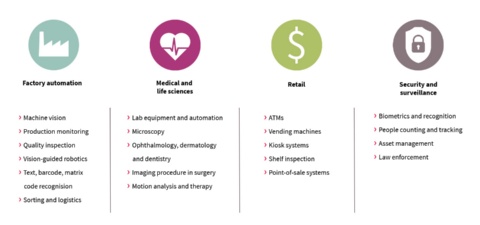EZ-USB™ CX3 MIPI CSI2至USB 5 Gbps相机控制器
Add USB 5Gbps connectivity to image sensors with MIPI CSI-2 interface
Infineon EZ-USB™ CX3 enables USB 5Gbps connectivity to any image sensor which is compliant with mobile industry processor interface (MIPI) camera serial interface type 2 (CSI-2) standard. Moreover, it also supports camera control interface (CCI) for image sensor configuration. EZ-USB™ CX3's multiple peripheral interfaces such as I2C, SPI, and UART can be programmed to support pan, tilt and zoom, or other camera control functions.
- Integrated USB 5Gbps PHY
- 32 USB endpoints
- MIPI CSI-2 RX interface
- 4x CSI-2 lanes, 1 Gbps per lane
- 200 MHz ARM926EJ-S core
- Connectivity to I2C, I2S, UART, SPI
- 12 GPIOs
- Supports 8-bit, RAW, YUV, RGB
- Adding USB 5 Gbps connectivity to any MIPI CSI-2 based camera
- Quick time-to-market with low development costs
- Turn-key solutions on industrial standards
Based on the proven EZ-USB™ FX3 platform, EZ-USB™ CX3 includes a fully accessible ARM9 CPU and 512 KB SRAM that provide 200 MIPS of computational power. Its multiple peripheral interfaces such as I2C, SPI, and UART can be programmed to support pan, tilt, and zoom or other camera control functions.
Users can benefit from the proprietary software with dedicated SDK including several EZ-USB™ FX3 firmware example projects, and a complete set of documentation to significantly speed up the development cycle. Once the design is completed, customers can take advantage of Infineon´s world-class customer support to review their schematics.

USB 3.2 can be beneficial in factory automation, medical and life sciences, retail, and security and surveillance.
Within factory automation, it can be used for machine vision, production monitoring, quality inspection, vision-guided robotics, text/barcode recognition, and sorting and logistics.
In medical and life sciences, it can be used in lab equipment and automation, microscopy, ophthalmology, dermatology, dentistry, 3D scanners for prosthetics creation, imaging procedures in surgery, and motion analysis and therapy.
In retail, USB 3.2 (formerly known as "Superspeed USB") can be beneficial for ATMs, vending machines, kiosks, shelf inspection, and point-of-sale systems.
In security and surveillance, it can be used in biometrics and recognition, people counting and tracking, asset management, and law enforcement.
Machine vision for industrial automation is a big and diverse market that has enjoyed double-digit annual growth in the past 10 years. With increasing sophistication of machine learning and the abundance of high-speed cameras, machine vision is expected to continue its growth trajectory in the next 10 years, touching even more applications and industries.
USB 3.2 is the heart of machine vision, ensuring flawless imagining and video streaming from 5 Gbps onwards while at the same time proving power-over-cable convenience, plug-and-play simplicity, and software interoperability.
- Check the CX3 reference design kit
- Download the CX3 datasheet, technical reference manual and RDK - documents, firmware, UVC video player
- Download and install the FX3 SDK setup
- Example firmware for OmniVision OV5640 and Aptina AS0260 image sensor interface
- Read the how to Interface a MIPI CSI-2 Image Sensor With EZ-USB® CX3 application note and refer to the SuperSpeed code examples
- Get your schematics reviewed by using the Online Tech Support Case System
Infineon´s family of EZ-USB™ peripheral controllers offers the most comprehensive USB product portfolio in the industry. Since 1996, it has led the industry by advancing features and performances in programmable USB peripheral controllers, allowing developers to create USB devices to meet the highest performance demands.
More importantly, Infineon’s premium customer support and long-term supply ensure that successful product lifecycles go beyond tens of years. EZ-USB™ portfolio offers the lowest total cost (bandwidth per dollar) solution for any high-speed system, shortens the time to market, and lowers the development costs by offering a turnkey solution including software and several design guides and documents, for commercial and industrial applications.
Since its introduction, USB has developed very quickly, evolving from the original 1.0 to the 2.0 by increasing by 40 times the data rate. With the continual push for higher speed came USB 3.0, which offered yet another 10x speed increase, reaching 5 Gbps.
High-capacity hard disk drives and high-speed cameras started taking advantage of the high data rate and made USB the go-to interface for storage, video streaming, and data acquisition applications. Since then, the USB bandwidth has been doubling every 4 years – from 5 Gbps to 10 Gbps, and then to 20 Gbps – keeping pace with the insatiable appetite for speed from the most demanding applications.




